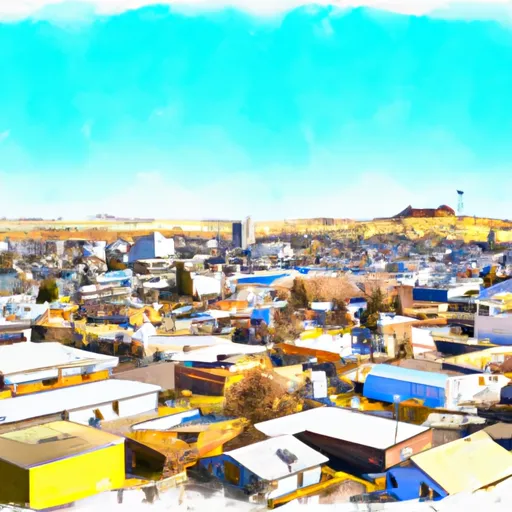-
 Snoflo Premium
Snoflo Premium
Get unlimited access to all our content
With no Ad interruptions! - Start Your Free Trial Login with existing account
Wallula
Eden Index
Climate
8.9
•
Recreation
4.7
•
Community
•
Safeguard
5.2/10

Wallula is a small town located in the southeastern part of Washington state. It lies within the Columbia Plateau and experiences a semi-arid climate with hot summers and cold winters. Summers are typically dry and hot, with temperatures averaging in the mid to high 80s Fahrenheit. Winters are cold, with temperatures dropping to the mid-20s Fahrenheit and occasional snowfall.
The town is situated near the confluence of the Columbia and Snake Rivers, making hydrology a significant aspect of the area. The Columbia River is the largest river in the Pacific Northwest and brings with it various hydrological constituents, including sediment, nutrients, and dissolved solids. This has helped create a diverse ecosystem and supports various fish species.
Outdoor recreation opportunities in Wallula are abundant. The nearby rivers provide opportunities for boating, fishing, and swimming. The Columbia River also offers ideal conditions for windsurfing and kiteboarding. The surrounding area is home to numerous hiking and biking trails, allowing visitors to explore the beautiful natural landscapes. Wildlife enthusiasts can enjoy bird-watching, as Wallula serves as a migratory pathway for many bird species. Overall, Wallula offers a mix of outdoor activities and scenic landscapes for nature enthusiasts to enjoy.
What is the Eden Index?
The Snoflo Eden Index serves as a comprehensive rating system for regions, evaluating their desirability through a holistic assessment of climate health, outdoor recreation opportunities, and natural disaster risk, acknowledging the profound impact of these factors on livability and well-being.
Climate Health Indicator (CHI): 8.9
Wallula receives approximately
263mm of rain per year,
with humidity levels near 68%
and air temperatures averaging around
12°C.
Wallula has a plant hardyness factor of
7, meaning
plants and agriculture in this region tend to thrive during the non-winter months.
By considering the ideal temperature range, reliable water supplies, clean air, and stable seasonal rain or snowpacks, the Climate Health Indicator (CHI) underscores the significance of a healthy climate as the foundation for quality living.
A healthy climate is paramount for ensuring a high quality of life and livability in a region, fostering both physical well-being and environmental harmony. This can be characterized by ideal temperatures, reliable access to water supplies, clean air, and consistent seasonal rain or snowpacks.
Weather Forecast
Streamflow Conditions
Middle Columbia
Area Rivers
Middle Columbia
Snowpack Depths
Middle Columbia
Reservoir Storage Capacity
Middle Columbia
Groundwater Levels
Recreational Opportunity Index (ROI): 4.7
The Recreational Opportunity Index (ROI) recognizes the value of outdoor recreational options, such as parks, hiking trails, camping sites, and fishing spots, while acknowledging that climate plays a pivotal role in ensuring the comfort and consistency of these experiences.
Access to outdoor recreational opportunities, encompassing activities such as parks, hiking, camping, and fishing, is crucial for overall well-being, and the climate plays a pivotal role in enabling and enhancing these experiences, ensuring that individuals can engage in nature-based activities comfortably and consistently.
Camping Areas
| Campground | Campsites | Reservations | Toilets | Showers | Elevation |
|---|---|---|---|---|---|
| Charbonneau Park | None | 459 ft | |||
| Hood Park | None | 352 ft | |||
| Ice Harbor Ramp - Lake Sacajawea | None | 448 ft | |||
| Fishhook Park | None | 465 ft | |||
| Lake Emma - Lake Sacajawea | None | 460 ft | |||
| Madame Dorion Park | None | 359 ft | |||
| Juniper Dunes OHV | None | 818 ft |
Nearby Ski Areas
Catastrophe Safeguard Index (CSI):
The Catastrophe Safeguard Index (CSI) recognizes that natural disaster risk, encompassing floods, fires, hurricanes, and tornadoes, can drastically affect safety and the overall appeal of an area.
The level of natural disaster risk in a region significantly affects safety and the overall livability, with climate change amplifying these risks by potentially increasing the frequency and intensity of events like floods, fires, hurricanes, and tornadoes, thereby posing substantial challenges to community resilience and well-being.
Community Resilience Indicator (CRI):
The Community Resilience Indicator (CRI) recognizes that education, healthcare, and socioeconomics are crucial to the well-being of a region. The CRI acknowledges the profound impact of these elements on residents' overall quality of life. By evaluating educational resources, healthcare accessibility, and economic inclusivity, the index captures the essential aspects that contribute to a thriving community, fostering resident satisfaction, equity, and social cohesion.

